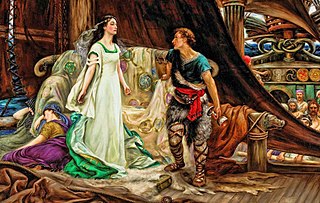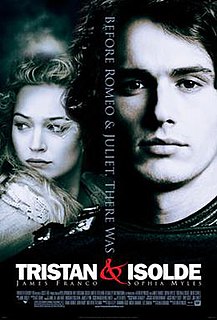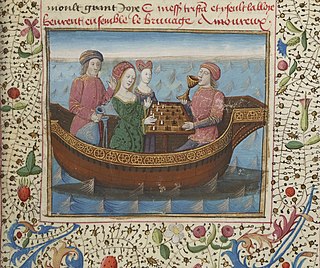 W
WTristan and Iseult, alternatively known as Tristan and Isolde, is a chivalric romance retold in numerous variations since the 12th century. The story is a tragedy about the adulterous love between the Cornish knight Tristan and the Irish princess Iseult ; while the details differ from one author to another, the overall plot structure remains much the same. The narrative predates and most likely influenced the Arthurian romance of Lancelot and Guinevere, and has had a substantial impact on Western art and literature.
 W
WIseult, alternatively Isolde is the name of several characters in the legend of Tristan and Iseult. The most prominent is Iseult of Ireland, the wife of Mark of Cornwall and the lover, later, the wife of Tristan. Her mother, the queen of Ireland, is also named Iseult. The third is Iseult of the White Hands, the daughter of Hoel of Brittany and the sister of Kahedin.
 W
WTristan, also known as Tristram or Tristain and similar names, is the hero of the legend of Tristan and Iseult.
 W
WSonia Essin was a Jewish-American contralto and educator who had an international career in operatic and classical music. She began her career in Europe before beginning a career in the United States on radio in the 1930s. Later in life she focused on vocal teaching.
 W
WTristan & Isolde is a 2006 British-American epic romantic drama film directed by Kevin Reynolds and written by Dean Georgaris based on the medieval romantic legend of Tristan and Isolde. Produced by Ridley Scott and Tony Scott, the film stars James Franco and Sophia Myles, alongside a supporting cast featuring Rufus Sewell, Mark Strong, and Henry Cavill. This was Franchise Pictures' last film before bankruptcy.
 W
WGottfried von Strassburg is the author of the Middle High German courtly romance Tristan, an adaptation of the 12th-century Tristan and Iseult legend. Gottfried's work is regarded, alongside the Nibelungenlied and Wolfram von Eschenbach's Parzival, as one of the great narrative masterpieces of the German Middle Ages. He is probably also the composer of a small number of surviving lyrics. His work became a source of inspiration for Richard Wagner's opera Tristan und Isolde (1865).
 W
WKing Hoel, also known as Sir Howel and Saint Hywel, was a late 5th- and early 6th-century member of the ruling dynasty of Cornouaille. He may have ruled Cornouaille jointly after the restoration of his father, Budic II of Brittany, but he seems to have predeceased his father and left his young son, Tewdwr, as Budic's heir.
 W
WMark of Cornwall was a king of Kernow (Cornwall) in the early 6th century. He is most famous for his appearance in Arthurian legend as the uncle of Tristan and the husband of Iseult, who engaged with Tristan in a secret liaison, giving Mark the epithet The Cuckold King.
 W
WTristan and Iseult is a children's novel by Rosemary Sutcliff and was first published in 1971. A re-telling of the ancient legend, it received the Boston-Globe Horn Book Award in 1972, and was runner-up for the 1972 Carnegie Medal.
 W
WTristan is a 1903 novella by German writer Thomas Mann set in a sanatorium. It contains many references to the myth of Tristan and Iseult. The novella alludes in particular to the version presented in Richard Wagner's opera of the same name. As such, it can be seen as an ironic paraphrase, juxtaposing the romantic heroism of Wagner's characters with their essentially flawed counterparts in the novella.
 W
WThe Prose Tristan is an adaptation of the Tristan and Iseult story into a long prose romance, and the first to tie the subject entirely into the arc of the Arthurian legend. It was also the first major Arthurian prose cycle commenced after the widely popular Lancelot-Grail, which influenced especially the later portions of the Prose Tristan.
 W
WTristan und Isolde, WWV 90, is an opera in three acts by Richard Wagner to a German libretto by the composer, based largely on the 12th-century romance Tristan and Iseult by Gottfried von Strassburg. It was composed between 1857 and 1859 and premiered at the Königliches Hoftheater und Nationaltheater in Munich on 10 June 1865 with Hans von Bülow conducting. Wagner referred to the work not as an opera, but called it "eine Handlung".
 W
WTristram and Iseult, published in 1852 by Matthew Arnold, is a narrative poem containing strong romantic and tragic themes. This poem draws upon the Tristan and Iseult legends which were popular with contemporary readers.